Major character or supporting player, like all of Jaime’s creations in this long-form tale, Daffy changes quite a bit visually during her fictional lifespan. And because Jaime uses the flashback technique pretty often in his stories, to fully document all of Daffy’s various styles, we have to begin with an image from late in volume one, during the “Wigwam Bam” storyline:
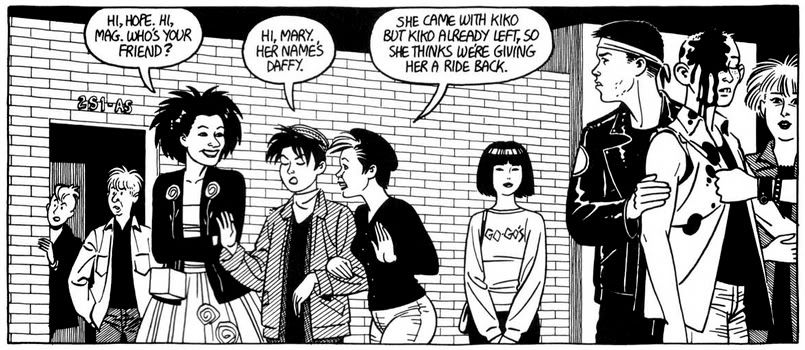 This is Daffy as she appears when she first meets Maggie and Hopey. Note Daffy’s Go-Go’s sweatshirt. The Go-Go’s began as a punk-related act but soon courted mainstream success with a softer, more pop-oriented New Wave/rock sound influenced by various girl groups of the 1960s. By giving her a more conventional suburban teen look, Jaime has visually marked Daffy as a softy within the social boundaries of the hardcore punk world Maggie and Hopey inhabit. Indeed, the two proceed to play a cruel trick on her, taking her to a house where she’s terrified and threatened with violent sexual intercourse by one of Jaime’s most outré minor characters, an angry female wrestling fan who sports hardcore S&M gear and a spiked… toy… of some kind.
This is Daffy as she appears when she first meets Maggie and Hopey. Note Daffy’s Go-Go’s sweatshirt. The Go-Go’s began as a punk-related act but soon courted mainstream success with a softer, more pop-oriented New Wave/rock sound influenced by various girl groups of the 1960s. By giving her a more conventional suburban teen look, Jaime has visually marked Daffy as a softy within the social boundaries of the hardcore punk world Maggie and Hopey inhabit. Indeed, the two proceed to play a cruel trick on her, taking her to a house where she’s terrified and threatened with violent sexual intercourse by one of Jaime’s most outré minor characters, an angry female wrestling fan who sports hardcore S&M gear and a spiked… toy… of some kind.Here you can see Daffy transition from naive teenybopper to only slightly less naive young woman in two panels marking the end of that sequence:
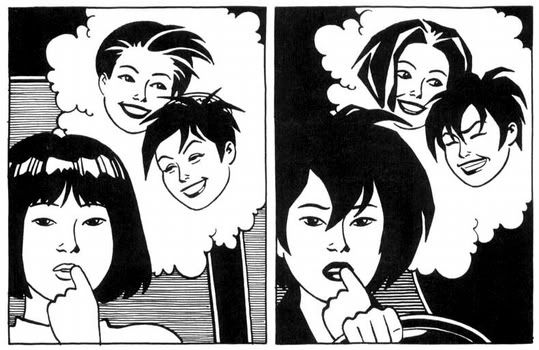 Despite her new friends' initial viciousness towards her—or because of it—Daffy becomes obsessed with Maggie and Hopey and allows them to use her and her rich girl trappings to their advantage.
Despite her new friends' initial viciousness towards her—or because of it—Daffy becomes obsessed with Maggie and Hopey and allows them to use her and her rich girl trappings to their advantage.Under their influence, Daffy quickly adopts an edgier image. With her hair bleached blonde and spiked wildly, she could almost be Hopey’s equal in terms of radical appearance. Here she is from one of the series’ earliest issues:
 The stories from this era feature science fiction and superhero trappings. Maggie sometimes visits exotic, pulp mag-like locations while she pursues a career as a "pro-solar mechanic," helping the dashing Rand Race repair spaceships. Jaime frames these sequences with interludes depicting Daffy and Hopey as they hang out waiting for Maggie's latest letter from Zymbodia or parts unknown. One wonders if perhaps these letters are creative fancies on Maggie's part as she accompanies her aunt on professional wrestling junkets, or endures fractious family vacations.
The stories from this era feature science fiction and superhero trappings. Maggie sometimes visits exotic, pulp mag-like locations while she pursues a career as a "pro-solar mechanic," helping the dashing Rand Race repair spaceships. Jaime frames these sequences with interludes depicting Daffy and Hopey as they hang out waiting for Maggie's latest letter from Zymbodia or parts unknown. One wonders if perhaps these letters are creative fancies on Maggie's part as she accompanies her aunt on professional wrestling junkets, or endures fractious family vacations.During this period, Daffy's and Hopey's personal styles sometimes overlap. Here, they both appear to have shopped at the same secondhand store, heavy on 1950s items:
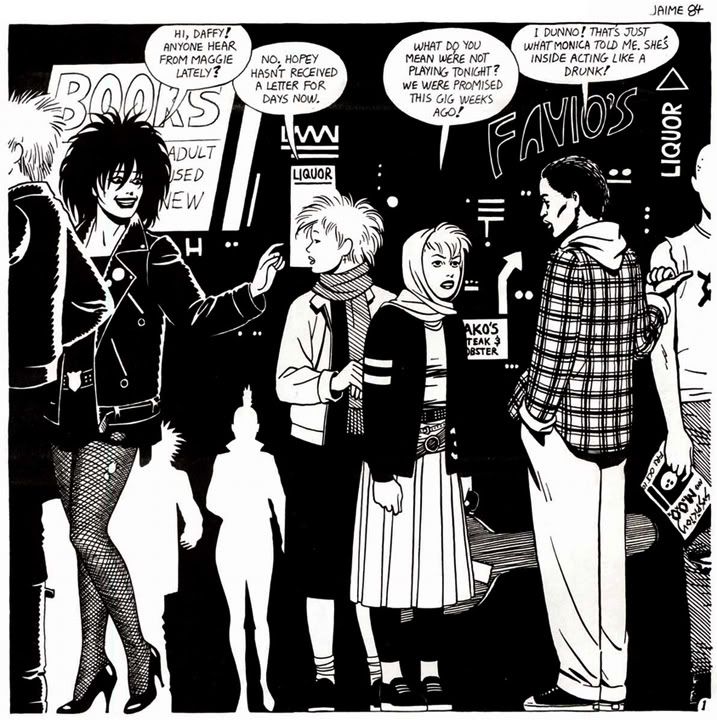 Turbulent Hopey and ditzy Daffy make for a strange, uneasy coupling. Fortunately, Hopey's self-interest and Daffy's need for some sort of connection and purpose in the group often coincide:
Turbulent Hopey and ditzy Daffy make for a strange, uneasy coupling. Fortunately, Hopey's self-interest and Daffy's need for some sort of connection and purpose in the group often coincide: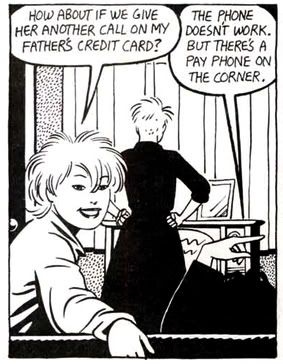 At other times, Hopey seems to delight in challenging or attacking Daffy's more Middle American hopes, dreams and aspirations. Here’s an image from "At the Beach," where Daffy sunbathes with Maggie, and looks quite fetching as she broils away in her bikini:
At other times, Hopey seems to delight in challenging or attacking Daffy's more Middle American hopes, dreams and aspirations. Here’s an image from "At the Beach," where Daffy sunbathes with Maggie, and looks quite fetching as she broils away in her bikini: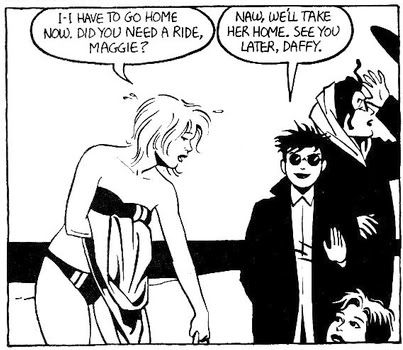 Daffy tells Maggie how when she's married to some rich guy, they'll sail together on a yacht to the islands every weekend. Within moments, Izzy and Hopey arrive dressed in vampiric black, a disconcerting image of noncomformity on the sunny sands, and Hopey gleefully goads Izzy into destroying Daffy’s romantic notions with a grotesque story that sends the poor girl fleeing back to her safe suburban enclave. Perhaps this incident is indicative of why Daffy no longer hangs out with Maggie and Hopey; she just doesn’t quite fit, as much as she’d love to.
Daffy tells Maggie how when she's married to some rich guy, they'll sail together on a yacht to the islands every weekend. Within moments, Izzy and Hopey arrive dressed in vampiric black, a disconcerting image of noncomformity on the sunny sands, and Hopey gleefully goads Izzy into destroying Daffy’s romantic notions with a grotesque story that sends the poor girl fleeing back to her safe suburban enclave. Perhaps this incident is indicative of why Daffy no longer hangs out with Maggie and Hopey; she just doesn’t quite fit, as much as she’d love to.At one point Daffy begins to metamorphize into the most fashion-forward of the original Locas, increasingly appearing as a chic young woman capable of taking chances with her outfits. Here's a panel detail from the 1987 story (just two years after "At the Beach"), "The Night Ape Sex Came Home to Play:"
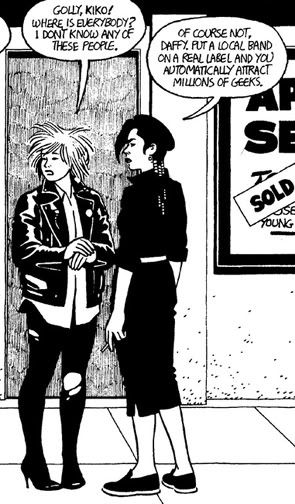 Here’s a sequence from "In the Valley of the Polar Bears, Part 2," in which she seems to be channeling Hopey with a more hardcore look. Ape Sex is a fictional band frequently referenced in the stories, apparently a local punk act that hit the big time:
Here’s a sequence from "In the Valley of the Polar Bears, Part 2," in which she seems to be channeling Hopey with a more hardcore look. Ape Sex is a fictional band frequently referenced in the stories, apparently a local punk act that hit the big time: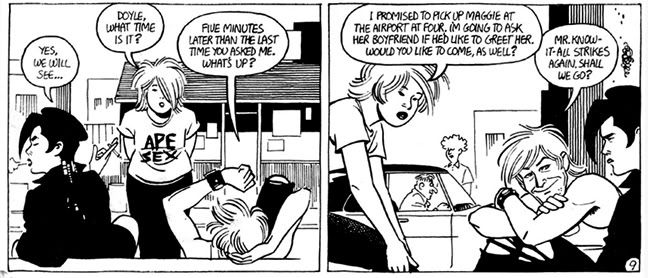 Here, Daffy allows her hair color to revert to its natural state and teases it up to almost Phyllis Diller-like proportions. This is Daffy during her sexy punk chica phase:
Here, Daffy allows her hair color to revert to its natural state and teases it up to almost Phyllis Diller-like proportions. This is Daffy during her sexy punk chica phase: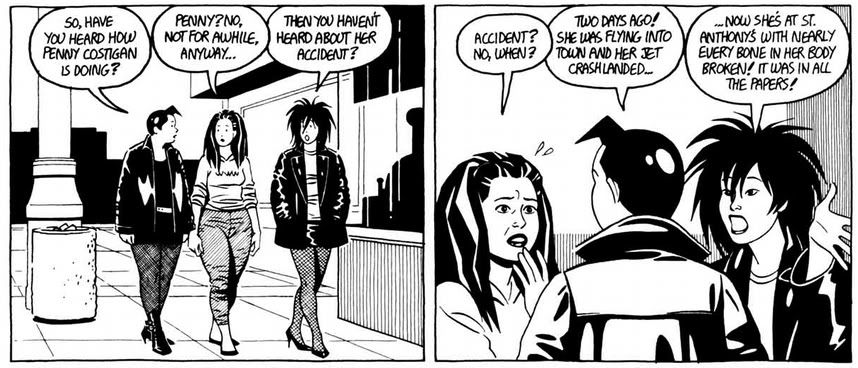 Here’s a gorgeous panel depicting Daffy and her sister Nami, with friend Itsuki. Daffy wears a stockperson's smock, but notice her sweet buckled, fat-treaded boots or perhaps monk shoes adding a little edge. After years on the fringe music scene, she’s developed a personal sense of style that’s quite unique even while working a minimum wage job. The smock almost becomes an ironic accent piece here, similar to how hip kids of my generation sometimes wore gas station shirts:
Here’s a gorgeous panel depicting Daffy and her sister Nami, with friend Itsuki. Daffy wears a stockperson's smock, but notice her sweet buckled, fat-treaded boots or perhaps monk shoes adding a little edge. After years on the fringe music scene, she’s developed a personal sense of style that’s quite unique even while working a minimum wage job. The smock almost becomes an ironic accent piece here, similar to how hip kids of my generation sometimes wore gas station shirts: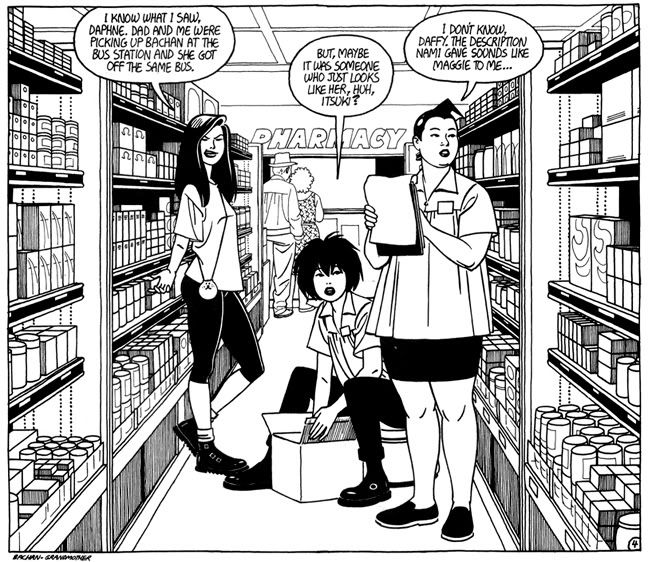 Check out the language footnote. Jaime and Gilberto frequently employ those to fill in cultural aspects of their casts readers might not be familiar with. Oba-chan is Japanese for "grandmother,” but Nami’s a typical American teen with typical American suburban ideas and substitutes a California permutation. Interesting also that Daffy's sister has a Japanese given name while Daffy's is European in origin.
Check out the language footnote. Jaime and Gilberto frequently employ those to fill in cultural aspects of their casts readers might not be familiar with. Oba-chan is Japanese for "grandmother,” but Nami’s a typical American teen with typical American suburban ideas and substitutes a California permutation. Interesting also that Daffy's sister has a Japanese given name while Daffy's is European in origin.Home on college break, Daffy begins an obsessive search for news about Maggie. At one point, she goes to Izzy's house in Hoppers. In this panel from "Wigwam Bam" part four, Daffy is quite striking with her short, teased hair and her all black ensemble, a cropped a-line coat, short-shorts, thigh high stockings and high-heeled pumps:
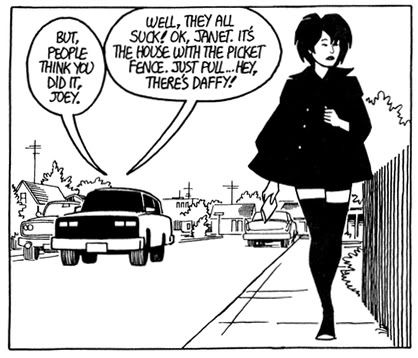 One of Jaime's most startling and alluring Daffy drawings. This represents a stylistically confident Daffy, her mature appearance somewhat at odds with her continued over-identification with Maggie and Hopey. If only her personality were as forceful as her fashion sense, she’d be quite the strong young woman.
One of Jaime's most startling and alluring Daffy drawings. This represents a stylistically confident Daffy, her mature appearance somewhat at odds with her continued over-identification with Maggie and Hopey. If only her personality were as forceful as her fashion sense, she’d be quite the strong young woman.
After Love and Rockets volume one gives way to the incredible (and much-missed) Penny Century series, Daffy’s appearances become even more sporadic. She's as rare and elusive as a cryptid cat. Here, in a panel from the first issue story "Locas," she seems to have taken a job in a research lab, a doctor’s office, or a dentist’s: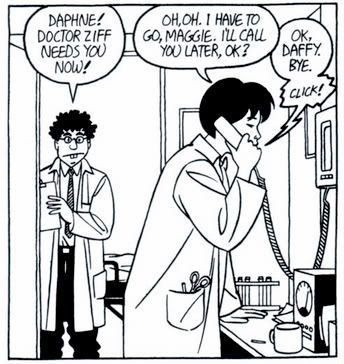 Tellingly, Jaime never bothers to inform the readers of Daffy’s professional status. Since the unnamed coworker in the background refers to a “Doctor Ziff“ and addresses Daffy more informally, we can infer she is not a doctor herself. Perhaps she’s a medical technician, or a nurse. The scissors in her pocket indicate some level of technical proficiency.
Tellingly, Jaime never bothers to inform the readers of Daffy’s professional status. Since the unnamed coworker in the background refers to a “Doctor Ziff“ and addresses Daffy more informally, we can infer she is not a doctor herself. Perhaps she’s a medical technician, or a nurse. The scissors in her pocket indicate some level of technical proficiency.
Daffy’s next appearance is in the flashback-driven tale "Everybody Loves Me Baby," from Penny Century #7, where she appears only to impart Hopey with some vital exposition. Other comic book writers should take note of how Jaime handles this; it’s not as direct or as clumsy as you’ll find in many other books. Instead, Jaime has it naturally flow via character business between Daffy and Hopey. The truly inspired work of a master storyteller at the top of his game: Here, Daffy appears in a classic black shift dress. Slick and grown up, impeccably groomed even hanging out with the more casually tomboyish Hopey, Daffy has achieved a fully mature style befitting a young professional with taste. Her short, spunky hairstyle even hints at a slight bit of uconventionality. Evidently, Maggie and Hopey have affected her for life.
Here, Daffy appears in a classic black shift dress. Slick and grown up, impeccably groomed even hanging out with the more casually tomboyish Hopey, Daffy has achieved a fully mature style befitting a young professional with taste. Her short, spunky hairstyle even hints at a slight bit of uconventionality. Evidently, Maggie and Hopey have affected her for life.
Who knows what future Jaime storylines will bring? Perhaps he’ll return Daffy to the narrative fold in some form or other. After Jaime wraps up the superhero stuff he’s onto now in Love and Rockets volume three, I would love to see a Daffy-centric storyline, perhaps one that recapitulates the series in its entirety via flashbacks from Daffy’s point of view. With the change to the new book format, it’d be a fantastic way to get new readers up to speed on who these people are, and Jaime could also update those us few Daffy fans in the audience on what she’s doing these days while Maggie continues to spin in place and Hopey gropes towards a belated sense of responsibility.
But I'm sure Jaime has better things a'-cookin'.
In the meantime, here’s a scene from Daffy’s lone appearance in Love and Rockets volume two. It's yet another flashback, and in her one line of dialogue, Jaime says a lot about her status within the gang:
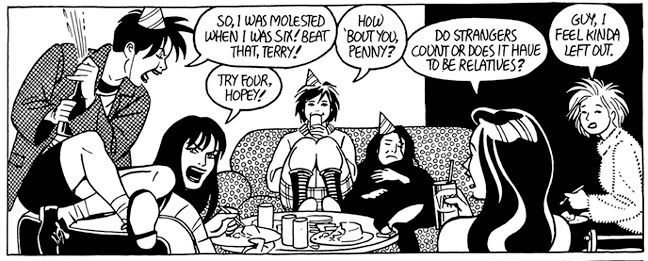 Poor Daffy. Only she could take something like a pissing contest over who was molested the most and the earliest and turn it into a personal crisis about her place among these fascinatingly flawed characters. Don’t sweat it, Daffy, you’re doing all right kid!
Poor Daffy. Only she could take something like a pissing contest over who was molested the most and the earliest and turn it into a personal crisis about her place among these fascinatingly flawed characters. Don’t sweat it, Daffy, you’re doing all right kid!

No comments:
Post a Comment